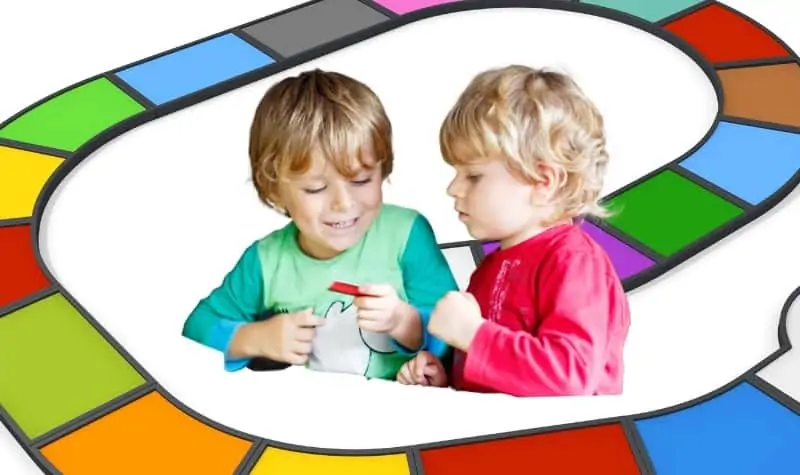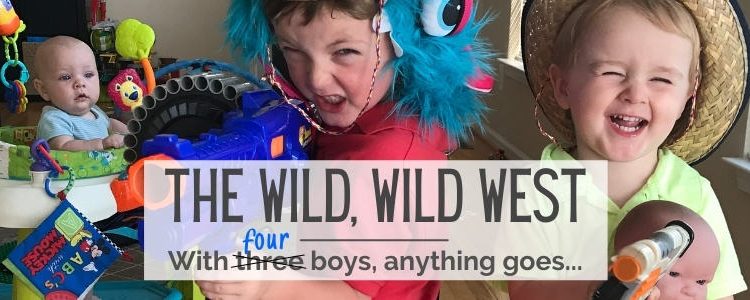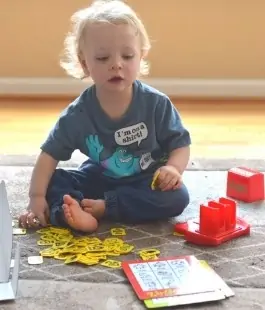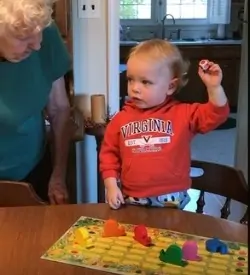
Finding the best board games for 3 year olds can be challenging because three is such a unique age. A 3 year old is still so baby-like in some ways, but so kid-like in others. Finding that perfect board game can be a bit like threading a small needle.
But don’t worry — I’ve got you covered. Raising four young boys, I can definitely tell you the best board games for your three year old. Even better, some of these games, while a perfect fit for a 3-year-old child, are also great for the entire family. Some of these board games have been on our family’s game shelves for years with no end in sight.

As an aside: this is meant to be a legitimate, factual, helpful review of these games. If you’re looking for a more hilarious assessment, you can check out my humorous rundown of the best board games for preschoolers here.
But first, some of the criteria I used to determine the best board games for three year olds…
All of the board games in this post are different, some dramatically so, but they all have a few things in common.
First, none of these board games require reading. A board game that requires reading is not appropriate for a three-year-old child. Of all the games on this list, I believe only three have words at all (Zingo!, Sequence, and Eye Found It). For those board games, the words are there as a supplement to a picture, not the main focus). If you erase the words, the game still functions exactly the same.
Second, none of these games have complicated rules. Even the games that have various difficulty levels for you to choose from, like Feed the Woozle, are all still very simple. (Don’t worry– simple doesn’t mean boring!)
Finally, all of these awesome board games for three year olds can be played by older siblings too. None of these games’ novelty or enjoyment expire when your child hits four. Most of these games can be enjoyed for years and by siblings of a variety of ages. Under each game’s description, I’ve tried to give you specific guidance about how long you can expect to use it, as some are best suited to kids prior to elementary school and some are good for years beyond.
Okay, now onto the board games. I hope you’ll agree with my assessment that these are the best board games for three year olds!
Sequence for Kids is one of my FAVORITE board games for three year olds.
I decided to open this board game guide with a game that’s sweet and simple. Sequence for Kids has an easy-to-grasp concept (get four spaces in a row). There are also some unique twists that make it palatable for older siblings (and parents).
Sequence for Kids
What’s great about this game is that, as long as your three-year-old understands the concept of four in a row, they can play. As they get older and more experienced, they’ll get better at the game, but their lack of skill or experience is no problem. They can play, and potentially win, from day one.
Something that makes this game great for a three year old is that you only hold three cards in your hand at a time. This makes it easy for their little hands and it doesn’t overwhelm them with too many things to consider.
Also, the board spaces and corresponding cards are animals. The animals’ names are printed in words on the cards along with a matching picture from the board. This is clutch for younger players because reading is not necessary.
There are a few cards that add an additional layer of strategy. One card, the unicorn, allows you to place your piece anywhere on the board. Another card, the dragon, allows you to remove any piece from the board.
As your child learns the game, they’ll get better at using these cards in a strategic way. But again, even on day one, they will still easily understand the concept of putting down or picking up a token from the board.
My kids are currently 1, just turned 4, 6, and 8, and we’ve all been loving this game for a year.
Hoot Owl Hoot
This game is like a cross between Candyland and Trouble. You move your pieces to a corresponding color space, a la Candyland. However, you have multiple pieces (owls) that you can choose to move, a la Trouble. The choice between different pieces allows your child to consider different strategies.
Having the choice is great because it makes this game enjoyable for a wider age range. Sure, even my six and eight-year-old still occasionally enjoy a game of Candyland, but the concept is a little simple and the novelty wears off quickly. Because players can decide which pieces to move, there is a more strategic element that allows your three-year-old to enjoy the game while also still entertaining older siblings.
Zingo!
This game was given to my oldest for his fourth birthday, which means my then-youngest (two years old at the time) was also playing– and he loved it. I think age three is really the perfect age to start this game, because the concept is simple and there is zero strategy involved.
The game is basically picture Bingo, with an element of tic-tac-toe. You use a slider to reveal two Bingo tiles per turn (the way you would remove Bingo balls in a Bingo hall). You race to claim the tiles and cover your Bingo boards. Covering three spaces in a row horizontally, vertically, or diagonally yields “Zingo!” (again, just like you would yell “Bingo!”).
You can also play the way my kids prefer — blackout Zingo. You only win when you’ve successfully covered your entire Zingo board. Again, this is a really simple concept for a three year old kid to understand. It does take significantly longer though, so you have to decide if your child has the attention span for this.
Another nice feature of this game is that the boards are double-sided. The red side is more unique, as in there is not much overlap between all the red cards. This makes the game less competitive (and in my house, less cut-throat). The soccer ball, for example, is less likely to appear on multiple cards and have multiple players clamoring for the same one.
To play the more competitive version, you use the green side of the card. Played that way, it’s highly likely that many of the players will be yelling for the same token (the bird, for example). This version of the game can be tougher for a three year old because they aren’t always paying close attention or quick to react.
At one point, we had a 2, 4, and 6-year-old playing this game regularly, so it has staying power.
Dragon’s Breath
Aside from the name, which is of course very popular with little boys, this is just a great board game. It actually won the Kinderspiel De Jahres in 2018 (which, although I don’t speak German, I understand means Children’s Game of the Year).
I like how simple this game is. There’s a cylindrical stack of circle rings, vaguely resembling ice crystals, with a pile of jewels inside. On their turn, a player lifts and removes the top circle ring from the stack (“melting the ice’). The goal is to lift as carefully as possible so as not to let the gems inside spill out. This is great fine motor practice for little hands, but of course, your three year old doesn’t know that.
Prior to each turn, players pick a color based on the gems they think are most likely to fall. If I choose green, and three green gems fall out on this turn, I collect them into my personal cave. At the end, whoever has collected the most gems wins. This is another great skill for young players to practice — making an educated prediction about what will happen next based on the evidence in front of them.
This game is simple, fun, and a great board game for any three year old. The only catch — the gems are relatively small, so if you have a crawler around, they are definitely a choking hazard.
Sneaky Snacky Squirrel
What I love most about this game is that it provides great fine motor practice for a three-year-old without making it seem like a “learning game,” if you know what I mean.
The child spins the spinner, which will land on a color. The child then collects an acorn of that color and places it in their log. The first player to collect all five colors wins.
What makes this game more fun and especially good fine motor practice is the “squeezer” tool. Each player collects their acorns using the “squeezer,” which is a squirrel-shaped tweezer. (Get it? Squirrel + tweezer = squeezer.)
This is great for working on fine motor control and hand strength. Plus, it just adds an additional fun (and sometimes funny) element to the game. This board game also comes in a little tree-shaped box, which I think adds a cute touch.
Unlike some of the other games I’ve mentioned so far, this one doesn’t lend itself to the older kids as much. I think this game is best suited for kids ages 2 through 5 (maybe six, depending on your child’s temperament).
Even so, I consider a game that’s under $20 and lasts for a few years to be a definite winner.
Feed the Woozle
Feed the Woozle is one of the best board games for three year olds because it’s a cooperative game. There is no winner or loser, which is a nice change of pace from some of the other games on this list. This can also be helpful if your three year old is easily set off by a loss.
Does your child need to learn to lose gracefully eventually? Of course. Does that lesson have to come during family game night while you’re juggling multiple kids at the end of a long day? Nope!
In Feed the Woozle, players work together to, you guessed it, feed the woozle. The woozle likes to eat fuzzy donuts and hairy pickles (kind of gross, which is part of the allure).
Players roll a dice to determine how many snacks they’ll have to feed the woozle. Then, using the special spoon from the game, they’ll spin a spinner to determine how they’ll feed that snack to the woozle. The spinner includes different silly options like hopping, spinning, etc. These are great for practicing balance, coordination, and a host of other gross motor skills. If the snack(s) fall off the special spoon, they don’t get to feed them to the woozle.
This game also comes with three different levels of difficulty. This is great because it means the board game doesn’t outgrow your child too quickly. Plus, once your three-year-old gets the hang of the game, upping the difficulty level makes it more enjoyable for older siblings.
If you really wanted to get creative with it, you could even have your kids work to generate new, weird ways to feed the woozle. You could put those ideas on cards (index cards, card stock, etc.) and draw them from a deck instead of using the spinner.
Snail’s Pace Race
I don’t think this game was around when I was a kid, but it’s also no newcomer either. My grandparents bought this board game for my three year old cousin roughly fifteen years ago and it is still going strong. Each one of my kids has loved playing it at their house.
Each player chooses a snail of a different color at the beginning of the game. The goal is for your snail to cross the finish line of the race first. On each turn, the player rolls two colored dice. Whatever colors come up, those are the snails that are moved that turn. So, for example, if your child rolls a blue and orange, then the blue and orange snail each advance one space.
What makes this a great board game for three year olds is that any snail can move at any time. This makes it easier to keep their attention when it’s not their turn. In fact, they could win the game on someone else’s turn (and when that happens, it seems to be even more exciting).
I think the reasonable age range for this game is 2-8, with the ideal range of this board game being three years old to six years old.
First Orchard
Like Feed the Woozle, this is the only other cooperative board game on this list. As such, it has the benefits of the players working together to achieve the goal: collect all the fruit from the orchard before the crow gets it.
This game reminds me of a cross between the Snail’s Pace Race and Sneaky Snacky Squirrel. It practices skills such as turn taking, color matching, and cooperative learning. Another benefit is that the pieces are large (each piece of fruit is roughly 2 inches x 3 inches), so it’s not a choking hazard to younger siblings who may be crawling around.
This is an ideal board game for two and three year olds. I think four year olds will also enjoy it, but that’s probably the maximum age for this game. That means you’ll get fewer years out of this game compared to some of the others on the list, but it’s perfect for households where you don’t want to be constantly policing little pieces or navigating complex rules.
If you want to see this game in action, the company, HABA, has included a super helpful video preview as part of the listing here on Amazon so you can get a sense of exactly how the game goes.
Eye Found It
This is a series that’s probably more card games than board games — or maybe a hybrid of the two. In any case, I love how simple and portable this game is. Rather than dealing with a bunch of pieces and set-up, you take out the deck, deal everyone in, and play.
I believe the official rules state that each person gets 5 cards and then you flip over the top card from the draw pile. That card reveals an item, say a clock. Essentially, you’re just playing I-Spy with the cards.
Each player examines their cards to see if there’s a clock pictured in the scenes on any of their five cards. If there is, they yell, “I found it!” and flip their card into the discard pile. The back of their card has a new item that everyone begins looking for (so, for example, their discarded scene card may have an apple on the back; that’s the new item everyone looks for on their own cards). The first player to get rid of all their cards wins.
This game can go quickly or slowly, depending on how many people you’re playing with and how skilled they are. When I play with my older two sons, we give everyone five cards. When I started playing this game with my son who had just turned three, I did three cards each.
Giving him fewer cards made it easier to thoroughly examine the scenes in front of him. After playing the game with him for a few months, he now plays with the full amount.
*When I was looking for a picture and link to the version we have, I discovered there’s actually an entire board game version of Disney Eye Found It. It seems to have more to it (an actual board, pieces, etc.), but the difficulty seems similar. The age on it says 4+, but I’m assuming that version would also be a great board game for three year olds (but I can’t personally vouch for that).
Connect 4
This game doesn’t really fit in with the rest of the board games on the list because it’s pretty old. Most of the games I discussed are a little newer and probably weren’t around when you were a kid yourself. Still, I felt like I should include at least one throwback and age three is a great time to introduce Connect 4 to kids.
I probably don’t need to go into a lot of detail about this game because most people are familiar with it — but it’s a classic for a reason! The simple premise — get four pieces in a row — makes it an easy board game for three-year-old kids to understand.
It’s also a great way to practice taking turns and developing the seeds of strategic thought. Admittedly, you probably won’t get a lot of strategy out of your three-year-old in this game. If they’re ever going to win, you’re going to have to let them win. BUT it’s still a great game for their age.
In our house, it’s clutch to train the kids in Connect 4 as early as possible because the earlier they master it, the sooner they can play against their older siblings (and give mom and dad a break!)
***
Board games are such a wonderful activity for kids. They help pass the time, sure, but they also teach valuable academic, social, and motor skills without kids even realizing it. Board games are my go-to gifts for holidays and birthdays because they last far longer than your average toy.
I hope you find that these are, in fact, fantastic board games for three year olds!
If you have any other board games your kids, grandkids, or students love, I’d love to hear about them in the comments!
If you enjoyed this post, you may also like:
The Best Read Aloud Books for Preschoolers













